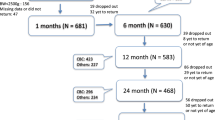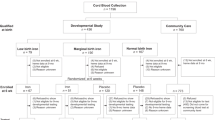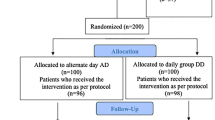Abstract
Background/Objectives:
Zinc (Zn) supplementation adversely affects iron status in animal and adult human studies, but few trials have included young infants. The objective of this study was to determine the effects of Zn and multivitamin (MV) supplementation on infant hematologic and iron status.
Subjects/Methods:
In a double-blind RCT, Tanzanian infants were randomized to daily, oral Zn, MV, Zn and MV or placebo treatment arms at the age of 6 weeks of life. Hemoglobin concentration (Hb) and red blood cell indices were measured at baseline and at 6, 12 and 18 months of age. Plasma samples from 589 infants were examined for iron deficiency (ID) at 6 months.
Results:
In logistic regression models, Zn treatment was associated with greater odds of ID (odds ratio (OR) 1.8 (95% confidence interval (CI) 1.0–3.3)) and MV treatment was associated with lower odds (OR 0.49 (95% CI 0.3–0.9)). In Cox models, MV was associated with a 28% reduction in risk of severe anemia (hazard ratio (HR)=0.72 (95% CI 0.56–0.94)) and a 26% reduction in the risk of severe microcytic anemia (HR=0.74 (0.56–0.96)) through 18 months. No effects of Zn on risk of anemia were seen. Infants treated with MV alone had higher mean Hb (9.9 g/dl (95% CI 9.7–10.1)) than those given placebo (9.6 g/dl (9.4–9.8)) or Zn alone (9.6 g/dl (9.4–9.7)).
Conclusions:
MV treatment improved iron status in infancy, whereas Zn worsened iron status but without an associated increase in risk for anemia. Infants in long-term Zn supplementation programs at risk for ID may benefit from screening and/or the addition of a MV supplement.
This is a preview of subscription content, access via your institution
Access options
Subscribe to this journal
Receive 12 print issues and online access
$259.00 per year
only $21.58 per issue
Buy this article
- Purchase on Springer Link
- Instant access to full article PDF
Prices may be subject to local taxes which are calculated during checkout
Similar content being viewed by others

References
Longo DL, Camaschella C . Iron-deficiency anemia. N Engl J Med 2015; 372: 1832–1843.
Iannotti LL, Tielsch JM, Black MM, Black RE . Iron supplementation in early childhood: health benefits and risks. Am J Clin Nutr 2006; 84: 1261–1276.
Crofton RW, Gvozdanovic D, Gvozdanovic S, Khin CC, Brunt PW, Mowat NA et al. Inorganic zinc and the intestinal absorption of ferrous iron. Am J Clin Nutr 1989; 50: 141–144.
Lim KHC, Riddell LJ, Nowson CA, Booth AO, Szymlek-Gay EA . Iron and zinc nutrition in the economically-developed world: a review. Nutrients 2013; 5: 3184–3211.
Olivares M, Pizarro F, Ruz M . Zinc inhibits nonheme iron bioavailability in humans. Biol Trace Elem Res 2007; 117: 7–14.
Rossander-Hultén L, Brune M, Sandström B, Lönnerdal B, Hallberg L . Competitive inhibition of iron absorption by manganese and zinc in humans. Am J Clin Nutr 1991; 54: 152–156.
Institute of Medicine Dietary Reference Intakes for Vitamin A, Vitamin K, Arsenic, Boron, Chromium, Copper, Iodine, Iron, Manganese, Molybdenum, Nickel, Silicon, Vanadium, and Zinc. National Academy Press: Washington, DC, USA, 2001.
Dijkhuizen MA, Wieringa FT, West CE, Martuti S, Martuti S . Effects of iron and zinc supplementation in Indonesian infants on micronutrient status and growth. J Nutr 2001; 131: 2860–2865.
Rosado JL, López P, Muñoz E, Martinez H, Allen LH . Zinc supplementation reduced morbidity, but neither zinc nor iron supplementation affected growth or body composition of Mexican preschoolers. Am J Clin Nutr 1997; 65: 13–19.
Brown KH, Peerson JM, Baker SK, Hess SY . Preventive zinc supplementation among infants, preschoolers, and older prepubertal children. Food Nutr Bull 2009; 30: S12–S40.
Dekker LH, Villamor E . Zinc supplementation in children is not associated with decreases in hemoglobin concentrations. J Nutr 2010; 140: 1035–1040.
Smuts CM, Lombard CJ, Benadé AJS, Dhansay MA, Berger J, Hop LT et al. Efficacy of a foodlet-based multiple micronutrient supplement for preventing growth faltering, anemia, and micronutrient deficiency of infants: the four country IRIS trial pooled data analysis. J Nutr 2005; 135: 631S–638S.
Ouédraogo HZ, Dramaix-Wilmet M, Zeba AN, Hennart P, Donnen P . Effect of iron or multiple micronutrient supplements on the prevalence of anaemia among anaemic young children of a malaria-endemic area: a randomized double-blind trial. Trop Med Int Health 2008; 13: 1257–1266.
Liu E, Duggan C, Manji KP, Kupka R, Aboud S, Bosch RJ et al. Multivitamin supplementation improves haematologic status in children born to HIV-positive women in Tanzania. J Int AIDS Soc 2013; 16: 180222.
McDonald CM, Manji KP, Kisenge R, Aboud S, Spiegelman D, Fawzi WW et al. Daily zinc, but not multivitamin supplementation, reduces diarrhea and upper respiratory infections in Tanzanian infants: a randomized, double-blind, placebo-controlled clinical trial. J Nutr 2015; 145: 2153–2160.
Erhardt JG, Estes JE, Pfeiffer CM, Biesalski HK, Craft NE . Combined measurement of ferritin, soluble transferrin receptor, retinol binding protein, and C-reactive protein by an inexpensive, sensitive, and simple sandwich enzyme-linked immunosorbent assay technique. J Nutr 2004; 134: 3127–3132.
Nathan DG, Orkin SH Nathan and Oski’s Hematology of Infancy and Childhood. 7th edn. Saunders/Elsevier: Philadelphia, PA, USA, 2009.
UNICEF, United Nations University, World Health Organization. Iron Deficiency Anaemia2001. Available at: http://www.who.int/nutrition/publications/en/ida_assessment_prevention_control.pdf.
Fischer Walker C, Kordas K, Stoltzfus RJ, Black RE . Interactive effects of iron and zinc on biochemical and functional outcomes in supplementation trials. Am J Clin Nutr 2005; 82: 5–12.
Lozoff B, Beard J, Connor J, Barbara F, Georgieff M, Schallert T . Long-lasting neural and behavioral effects of iron deficiency in infancy. Nutr Rev 2006; 64: S34–S43. discussionS72–91.
Armony-Sivan R, Angelilli ML, Jacobson SW . Dose-response relationships between iron deficiency with or without anemia and infant social-emotional behavior. J Pediatr 2008; 152: 696–702.
Shafir T, Angulo-Barroso R, Jing Y, Angelilli ML, Jacobson SW, Lozoff B . Iron deficiency and infant motor development. Early Hum Dev 2008; 84: 479–485.
Carter RC, Jacobson JL, Burden MJ, Armony-Sivan R, Dodge NC, Angelilli ML et al. Iron deficiency anemia and cognitive function in infancy. Pediatrics 2010; 126: e427–e434.
Herman S, Griffin IJ, Suwarti S, Ernawati F, Permaesih D, Pambudi D et al. Cofortification of iron-fortified flour with zinc sulfate, but not zinc oxide, decreases iron absorption in Indonesian children. Am J Clin Nutr 2002; 76: 813–817.
Davidsson L, Walczyk T, Zavaleta N, Hurrell R . Improving iron absorption from a Peruvian school breakfast meal by adding ascorbic acid or Na2EDTA. Am J Clin Nutr 2001; 73: 283–287.
Shiva Shankar Reddy CS, Subramanyam MVV, Vani R, Asha Devi S . In vitro models of oxidative stress in rat erythrocytes: effect of antioxidant supplements. Toxicol In Vitro 2007; 21: 1355–1364.
Niki E, Komuro E, Takahashi M, Urano S, Ito E, Terao K . Oxidative hemolysis of erythrocytes and its inhibition by free radical scavengers. J Biol Chem 1988; 263: 19809–19814.
Ma AG, Schouten EG, Zhang FZ, Kok FJ, Yang F, Jiang DC et al. Retinol and riboflavin supplementation decreases the prevalence of anemia in Chinese pregnant women taking iron and folic Acid supplements. J Nutr 2008; 138: 1946–1950.
Papathakis PC, Rollins NC, Chantry CJ, Bennish ML, Brown KH . Micronutrient status during lactation in HIV-infected and HIV-uninfected South African women during the first 6 mo after delivery. Am J Clin Nutr 2007; 85: 182–192.
Acknowledgements
We are grateful to the field and study staff for their tireless efforts: Esther Kibona (deceased), Frank Killa, Michel Alexander, Phares Zawadi, Susie Welty, Rachel Steinfeld, Anne Marie Darling, James Okuma, Angela Jardin, Elizabeth Long, Jenna Golan and Emily Dantzer. The study was supported by NIH (R01 HD048969; K24DK104676; 2P30 DK040561; K23 AA 020516); Bill and Melinda Gates Foundation (OPP1066203).
Author contributions
All authors have read and approved the submitted version of this manuscript. RCC analyzed the data and wrote the manuscript; KM designed the study, supervised data collection and provided inputs to the manuscript; SA oversaw all laboratory aspects of the study and reviewed the manuscript; JGE performed iron status assays, assisted with results interpretation and reviewed the manuscript; KG assisted with study design, sample management and reviewed the manuscript; RK provided inputs to the study design, oversaw data collection and reviewed the manuscript; EL assisted with statistical analysis and reviewed the manuscript; WF designed the study, provided inputs to the statistical analysis and reviewed the manuscript; CMM oversaw data management, provided inputs to the statistical analysis and reviewed the manuscript; and CD designed the study, oversaw study implementation, contributed to the statistical analysis and provided inputs to the manuscript.
Disclaimer
The opinions and statements in this article are those of the authors and may not reflect official UNICEF policies.
Author information
Authors and Affiliations
Corresponding author
Ethics declarations
Competing interests
Juergen Erhardt is the owner of the company VitMin Lab (Willstaett, Germany), where some of the assays performed in this study were conducted. Roland Kupka is a UNICEF staff member. The remaining authors declare no conflict of interest.
Rights and permissions
About this article
Cite this article
Carter, R., Kupka, R., Manji, K. et al. Zinc and multivitamin supplementation have contrasting effects on infant iron status: a randomized, double-blind, placebo-controlled clinical trial. Eur J Clin Nutr 72, 130–135 (2018). https://doi.org/10.1038/ejcn.2017.138
Received:
Revised:
Accepted:
Published:
Issue Date:
DOI: https://doi.org/10.1038/ejcn.2017.138


